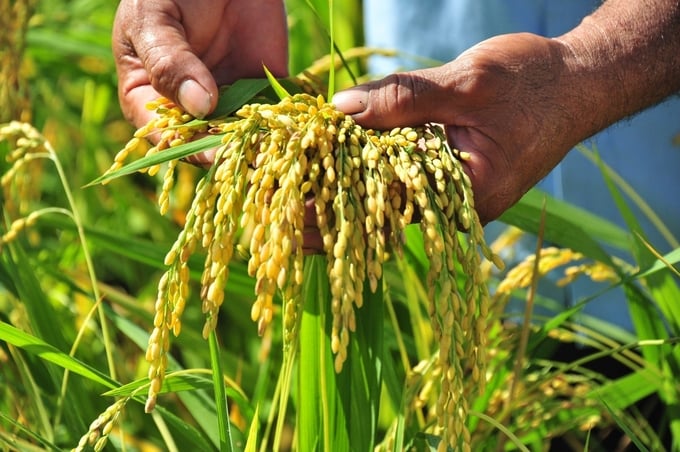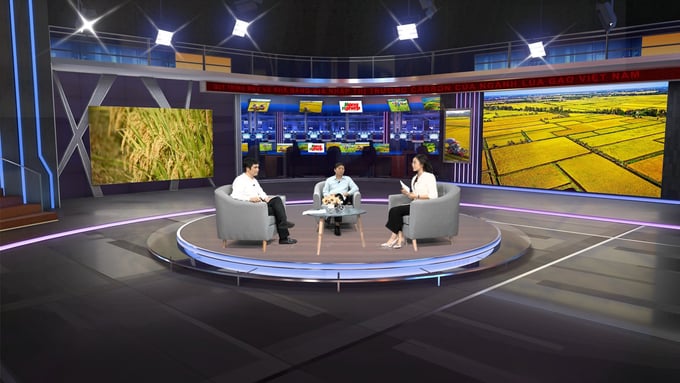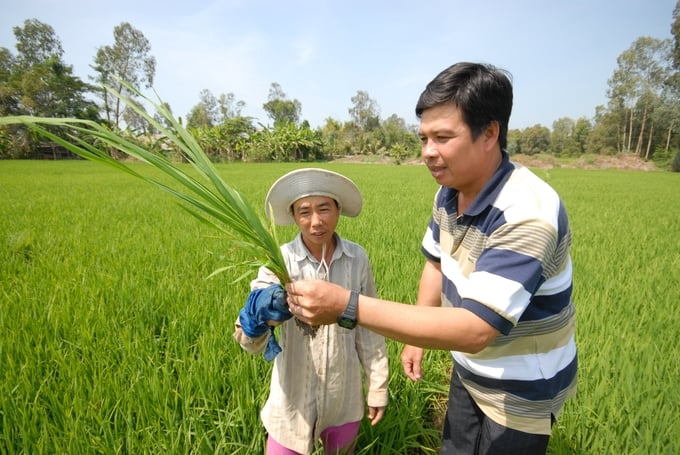June 19, 2025 | 18:54 GMT +7
June 19, 2025 | 18:54 GMT +7
Hotline: 0913.378.918
June 19, 2025 | 18:54 GMT +7
Hotline: 0913.378.918

MRV opens opportunities for Vietnam to lead in sustainable rice production. Photo: Pham Huy.
The MRV process, which stands for Measurement, Reporting, and Verification, has been emphasized in the Paris Agreement on climate change as a crucial tool for ensuring the transparency of GHG emission reduction, with an aim towards carbon neutrality by 2050.
For the rice sector, MRV is not only the key to entering the global carbon market but also opens opportunities for Vietnam to lead in sustainable rice production. MRV helps ensure the transparency and reliability of emission reduction data, thereby creating valuable carbon credits.
To clarify the potential of MRV application in rice cultivation, Vietnam Agriculture News hosts a talk show with Dr. Mai Van Trinh, Director of the Institute of Agricultural Environment, an expert with extensive experience building and implementing MRV in rice production.
The second guest speaker is Dr. Tran Cong Thang, Director of the Institute of Policy and Strategy for Agricultural and Rural Development, who plays a crucial role in developing the project for 1 million hectares of high-quality, low-emission rice cultivation as well as policies to connect the Vietnamese rice market with the global carbon market.
Question for Mr. Mai Van Trinh, sir, carbon credits generated from emission reduction projects only hold value when they are verified through the MRV process. Based on your experience with projects conducted by the Institute of Agricultural Environment, what do you think are the biggest challenges in implementing the MRV process for Vietnam's rice sector?
Dr. Mai Van Trinh: In the agricultural sector in general, all emission reduction activities are evaluated by verifying the amount of reduced emissions. Thus, the role of MRV is very important. All GHG emission reduction activities must be verified for the specific technology applied, under what conditions, and how much emission reduction was achieved – or ultimately, how many carbon credits were earned for the carbon market.
The MRV activities face quite a few challenges. For example, farmers’ practices are almost the biggest challenge. They use nitrogen fertilizer heavily, plant densely, use old seedlings, and apply nitrogen fertilizer based on perception.
The second challenge is that the field conditions in Vietnam are fragmented and small-scale, so it’s challenging to standardize or guide farmers to practice uniformly.
Third is the consistency in cultivation practices. Some farmers strictly follow procedures, while others may skip certain steps.

Agricultural experts share insights in talk show "MRV process and carbon market access potential of Vietnam’s rice industry". Photo: Pham Huy.
This greatly impacts the quality of GHG emission reduction, which compromises MRV data quality. Weather conditions are very important for advanced MRV technology, such as using satellite imagery. If the weather is cloudy, the satellites can be obstructed, and we will lose information in areas where clouds block the view. During the rainy season, continuous flooding can prevent farmers from carrying out emission reduction activities.
In such cases, MRV technology struggles to determine how much water the farmers have withdrawn. According to the IPCC guidelines, successful water withdrawal is defined as either a single successful instance or multiple successful instances. Only then can emission reduction factors be applied accurately.
Thank you. So, MRV can be seen as a tool for quantifying the sustainability of farmers' practices. Therefore, the next question is for Mr. Tran Cong Thang. Sir, could you share the policies’ role in supporting the MRV process's transparency and developing the rice sector's carbon market? Could you provide some policies currently being researched and implemented by the Government and the MARD within the framework of the 1 Million Hectares of High-Quality, Low-Emission Rice Project?
Dr. Tran Cong Thang: Previously, with the VNSAT project, which focused on sustainable agriculture, we did quite well. However, developing that project took several years. As we aim to scale up to 1 million hectares, the government and the Ministry of Agriculture have set very clear objectives.
Particularly in the first phase, from 2024 to 2025, we will consolidate and reassess the VNSAT projects. We have made positive progress I may say, and we are expanding and developing many initiatives.
We are specifically building what we call “model farms.” These model farms apply high-quality, low-emission rice cultivation practices. We then implement measures to measure how much emission reduction we achieve.
The World Bank and the International Rice Research Institute have stated that this is the first project of its kind globally on such a large scale. In light of this, the Government, the Ministry of Agriculture and Rural Development, and the Ministry of Natural Resources and Environment are implementing many policies.

Vietnam needs regulations and policies to gradually develop certification for high-quality, low-emission rice production and a market framework for it. Photo: Le Hoang Vu.
The State Bank of Vietnam is also developing a credit program to support this project. This policy is important to assist farmers, cooperatives, and businesses. To date, the State Bank has conducted surveys and evaluations and is working on a draft proposal.
The most crucial thing is to have a policy framework that regulates these aspects. We need regulations and policies to gradually develop certification for high-quality, low-emission rice production and a market framework for it.
We are amending Decree 06, which provides a comprehensive policy framework for emission reduction and ozone layer protection regulations.
Additional regulations related to the carbon market will be introduced in the upcoming phase. Pilot projects are expected to be completed by 2028. We need various regulations to create a feasible pathway.
Besides setting regulations for certification, we must operate the market so that the MRV process can issue carbon credits to rice growers, cooperatives, and businesses, which can then be traded in the market.
Thank you, sir!
![Turning wind and rain into action: [9] Digitizing hydrometeorological data in response to climate change](https://t.ex-cdn.com/nongnghiepmoitruong.vn/608w/files/news/2025/06/17/z6704423696987_15fd32ffc26d590d204d520c9dac6786-nongnghiep-165943.jpg)
(VAN) Farmers have begun accessing hydrometeorological applications to adjust their cropping schedules, aiming to ensure productivity and adapt to climate change.
![Turning wind and rain into action: [8] Real-time salinity detection and early warning technology](https://t.ex-cdn.com/nongnghiepmoitruong.vn/608w/files/news/2025/06/17/z6704423696987_15fd32ffc26d590d204d520c9dac6786-nongnghiep-151127.jpg)
(VAN) Thanks to the integration of modern hydrological-hydraulic models, remote sensing technologies, and artificial intelligence, the accuracy of hydrological forecasting has significantly improved.
![Turning wind and rain into action: [7] Early disaster warnings help marine farmers minimize losses](https://t.ex-cdn.com/nongnghiepmoitruong.vn/608w/files/news/2025/06/17/z6704423696987_15fd32ffc26d590d204d520c9dac6786-nongnghiep-142942.jpg)
(VAN) In recent years, thanks to early disaster warnings and forecasting, marine farmers in Khanh Hoa province have been able to reduce risks and losses, thereby improving production efficiency.
![Turning wind and rain into action: [6] ‘Four on-the-spot’ disaster management software](https://t.ex-cdn.com/nongnghiepmoitruong.vn/608w/files/news/2025/06/17/e5a48259d6a262fc3bb3-nongnghiep-183800.jpg)
(VAN) By simply activating the scenario on the disaster management software, the relevant authorities immediately know how many households need to be evacuated, where to evacuate them to, and by what means of transportation…
![Turning wind and rain into action: [5] Hue applies modern technology in disaster forecasting](https://t.ex-cdn.com/nongnghiepmoitruong.vn/608w/files/news/2025/06/17/z6704423696987_15fd32ffc26d590d204d520c9dac6786-nongnghiep-093938.jpg)
(VAN) In Hue city, modern technology has recently been applied in meteorological and hydrological forecasting and warning, helping to reduce the damage caused by natural disasters.

(VAN) A cutting-edge farming technique being implemented on an experimental ranch in Arizona's Sonoran Desert has already saved a billion gallons of water over five years, according to Civil Eats.

(VAN) Poultry and pig production and the environment can be boosted through enhanced water technology, according to new research.